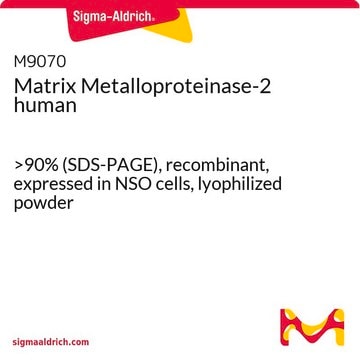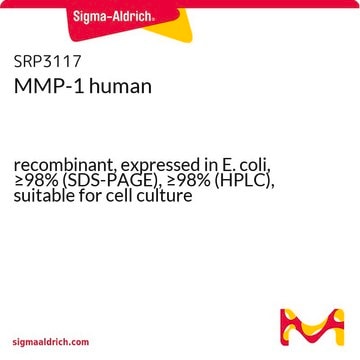This product can be activated in vitro by adding 4-Aminophenylmercuric acetate (APMA), Cat. No. A9563, to a final concentration of 1 mM. The product is sold in a 50 µg pack size. The concentration is lot specific and may be found on the certificate of analysis. Based on the 50 - 200 µg/mL protein concentration specification, the volume may range from 0.25 - 1 mL. Please see the link below to review additional information available in the product datasheet:_x000D_
https://www.sigmaaldrich.com/deepweb/assets/sigmaaldrich/product/documents/314/186/sae0077pis.pdf
SAE0077
MMP-9 human
recombinant, ≥1,300 pmol/min/μg, expressed in HEK 293 cells
Sinónimos:
GELBCLG4B, Gelatinase, Gelatinase B, MANDP2, MMP-9, Matrix Metalloproteinase-9, Type IV collagenase
Seleccione un Tamaño
Seleccione un Tamaño
About This Item
Productos recomendados
origen biológico
human
Nivel de calidad
recombinante
expressed in HEK 293 cells
Ensayo
95% (SDS-PAGE)
Formulario
liquid
mol peso
calculated mol wt 76 kDa
observed mol wt 92 kDa (The protein migrates as a 92 kDa protein on SDS-PAGE due to glycosylation)
concentración
50-200 μg/mL
Nº de acceso UniProt
aplicaciones
cell analysis
Condiciones de envío
dry ice
temp. de almacenamiento
−20°C
Información sobre el gen
human ... MMP(4318)
Descripción general
Acciones bioquímicas o fisiológicas
MMP-9 is secreted from neutrophils, macrophages, and a number of transformed cells, and is the most complex family member in terms of domain structure and regulation of its activity.
Structurally, MMP9 maybe be divided into five distinct domains: a pro-domain which is cleaved upon activation, a gelatin binding domain consisting of three contiguous fibronectin type II units, a catalytic domain containing the zinc binding site, a proline rich linker region, and a carboxyl terminal hemopexin like domain.
Otras notas
Forma física
Código de clase de almacenamiento
12 - Non Combustible Liquids
Clase de riesgo para el agua (WGK)
WGK 1
Punto de inflamabilidad (°F)
Not applicable
Punto de inflamabilidad (°C)
Not applicable
Elija entre una de las versiones más recientes:
Certificados de análisis (COA)
¿No ve la versión correcta?
Si necesita una versión concreta, puede buscar un certificado específico por el número de lote.
¿Ya tiene este producto?
Encuentre la documentación para los productos que ha comprado recientemente en la Biblioteca de documentos.
Los clientes también vieron
-
I would like to inquire whether the MMP9 Human (Reference SAE0077-50ug, Lot#107M4777V) requires activation. If so, could you kindly provide the recommended protocol for activation? Could you please confirm the volume in which it is supplied?
1 answer-
Helpful?
-
Active Filters
Nuestro equipo de científicos tiene experiencia en todas las áreas de investigación: Ciencias de la vida, Ciencia de los materiales, Síntesis química, Cromatografía, Analítica y muchas otras.
Póngase en contacto con el Servicio técnico









